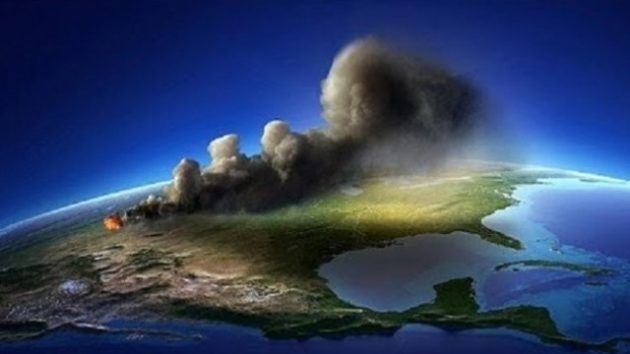Earthquake and Volcano Threat for U.S. Increases
In a rare letter to Mr. Craig Fugate, the Administrator of the Federal Emergency Management Agency (FEMA), the Orlando, FL based Space and Science Research Corporation (SSRC), has disclosed that we are about to enter a potentially catastrophic period of record earthquakes and volcanic eruptions throughout the United States.
The letter was signed by SSRC President, Mr. John Casey, and delivered to FEMA headquarters in Washington, D.C. today. In the letter, Mr. Casey outlines how the ongoing dramatic reduction in the Sun’s energy output will not only plunge the world into a decades-long cold epoch, but at the same time bring record geophysical devastation in monster earthquakes and volcanic eruptions. These cold climate periods called “solar hibernations” or “solar minimums,” are well known phenomena in the solar physics community. The SSRC has done important pioneering work in the field of solar- climate modeling and has established itself as a leader in climate prediction and the study of these hibernations of the Sun.
Citing new research included in the SSRC’s semi-annual Global Climate Status Report (GCSR) to come out on Wednesday, the letter to FEMA’s Craig Fugate contained an important warning for all major earthquake fault zones and volcanically active areas. The research focuses especially on the increased threat for the New Madrid Seismic Zone (NMSZ) between St. Louis and Memphis.
This new threat information is contained in one of several papers in the June 10 edition of the GCSR paper authored by Mr. Casey and Dr. Dong Choi, Director of Research for the International Earthquake and Volcano Prediction Center (IEVPC). The paper shows that the NMSZ is due for another calamitous quake between 2017 and 2038. Dr. Choi and Casey show that for four times in a row since the year 1450, a major quake strikes the NMSZ when the Sun has gone into a hibernation phase. This scientific revelation is what Choi and Casey believes solves the puzzle of when the next major quake will strike the area. Geologists have studied the NMSZ for many years using traditional approaches. Casey and Choi say it is the combined research from the fields of solar physics and geology that provides the best opportunity to date to estimate when the next devastating NMSZ earthquake will strike. Other scientists agree with their opinion.
For this singular reason Dr. Choi and Mr. Casey have strongly recommended to FEMA Administrator Fugate that all high risk earthquake fault zones and areas with a history of volcanic eruptions in the USA take immediate precautions to mitigate what they describe as a “period of unparalleled geophysical lethality and destruction.”
Mr. Casey adds, “The very strong correlation between these solar minimums and the incidence of catastrophic earthquakes worldwide is an impressive display of how interconnected we all are to our natural world and the cycles of the Sun. It would be foolhardy to ignore in particular, the history of major earthquakes in the NMSZ and the fact that at the bottom of every solar hibernation for the past 600 years, that area has seen devastating earthquakes ranging from M6.8 to M8.0.
“While we address the New Madrid risk in this press release and in the June 10, 2016 Global Climate Status Report, the coincidence of major earthquakes with solar minimums is not limited to just that area of the U.S. That is why our letter to Administrator Fugate was a nationwide alert. The ~M9.0 Cascadia quake and tsunami of 1700 was at the bottom of the coldest solar hibernation period which was called the Maunder Minimum. The Great San Francisco quake of 1906 was at the bottom of another solar low point – the ‘Centennial’ Minimum as it is called at the SSRC. This strong association of solar activity and the worst earthquakes and volcanic eruptions could represent the ‘missing link’ for geophysical disaster prediction.”
Dr. Choi (Australia) also supports Casey’s opinion by saying, “The extensive research done in this area is clear in its implications. When the solar minimums arrive, the worst recorded earthquakes and volcanic eruptions strike. The last solar minimum for example, saw the largest series of earthquakes in human history in the NMSZ and the largest recorded volcanic eruption at Mt. Tambora in Indonesia. These events occurred within a few years of each other during the coldest period in the Sun’s last hibernation in the early 1800’s.”
Click Here to Download The Letter to the FEMA Administrator



Do the effects of CERNs on the magnetosphere (during its high output) add to the effects of little or no flaring or filament release (even though we still get coronal hole influence during this minimum we are in) in causing major quakes and volcanism?
What are the chances of the Yellow Stone volcano erupting again?
Which are the other super-volcanos that can erupt in the next 10 years?
Vikram,
Thanks for reading and commenting.
There are about 20 known supervolcanoes on Earth – including Lake Toba in Indonesia, Lake Taupo in New Zealand, and the somewhat smaller Phlegraean Fields near Naples, Italy.
We are currently in a solar minimum (few to no sun spots). Data tells us that during a period of solar minimum there will be increased numbers of earthquakes and volcanic eruptions. Please visit the International Earthquake and Volcano Prediction Center website to learn more.